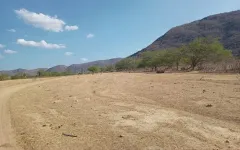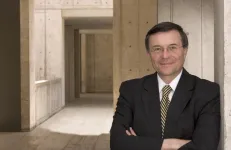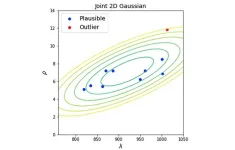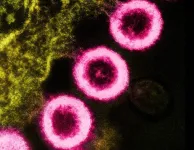(Press-News.org) Strategies deployed for the restoration of degraded land have had promising results in Brazil’s semi-arid region, improving the microbial properties of the soil and contributing to a return of native ecosystem services. The techniques include removal of cattle or restriction of their access to specific areas of pasture; cultivation of cover crops; and terracing to control erosion. Recovery of soil microbial properties maintains biodiversity and raises crop yields, contributing to agricultural sustainability.
These are the main findings of a study reported in the Journal of Environmental Management by a Brazilian research group comprising scientists affiliated with the University of São Paulo (USP), the Federal University of Piauí (UFPI), the Federal University of Ceará (UFC), and the Federal University of the Agreste of Pernambuco (UFAPE). The review article encompasses 18 studies conducted in the semi-arid region, especially the Caatinga, a local biome consisting mainly of deciduous thorn forest.
The area susceptible to desertification corresponds to 70% of the Northeast region, or about 16% of Brazil’s total landmass. It contains more than 1,400 municipalities (out of a nationwide total of 5,570) and spans nine states with an aggregate population of 35 million.
Biodiversity is high in the Caatinga, with some 600 species of birds, 240 species of fish and 170 species of mammals, among others. Family farmers are very much in the majority and are particularly exposed to climate risk. The main family farming municipalities have suffered severe production losses in the past three decades.
According to a study by the Climate Policy Initiative at the Pontifical Catholic University of Rio de Janeiro (CPI/PUC-Rio), the increase in drought events in the Caatinga correlates with higher yield losses for beans (16%) and corn (35%) compared with other biomes (6% and 16% respectively). In the case of cattle raising, productivity falls 9% in the Caatinga but rises 1% elsewhere.
“We set out to understand the soil microbiome and its functions in order to identify tools that can help restore degraded areas in the semi-arid region. We found that restoration techniques have led to a return of microbial diversity and hence a resumption of ecosystem services and functions similar to what they were naturally,” Lucas William Mendes, last author of the article, told Agência FAPESP. Mendes is a professor at the University of São Paulo’s Center for Nuclear Energy in Agriculture (CENA-USP). He is supported by FAPESP via two projects (19/16043-7 and 20/12890-4).
About the soil microbiome
The soil microbiome is the community of microorganisms – bacteria, fungi, archaea, protists and viruses – that live in soil, along with their genetic material, functions, and relationships with the environment. It plays an important role in nutrient cycling, organic matter decomposition, greenhouse gas emissions, and plant health.
Microorganisms are involved in the formation and stabilization of carbon-rich organic matter, contributing to carbon sequestration and mitigating the effects of climate change. “By understanding how some microorganisms live in drought-ridden areas and contribute to plant growth there, we can discover novel inoculants for use in developing vegetation in semi-arid regions,” Mendes said.
An analysis of the effects of restoration techniques on the soil microbiome highlights land quality as a basis for reducing synthetic inputs and leveraging biotechnological potential to implement sustainable practices.
Sustainability is the current focus for the G20 Agriculture Working Group. Comprising 19 countries, the European Union and the African Union, the G20 is chaired by Brazil this year. The summit for heads of state and government will be held in November in Rio de Janeiro.
For Erika Valente de Medeiros and Diogo Paes da Costa, professors at UFAPE and co-authors of the article, research of this kind can provide vital knowledge for policymakers to devise sustainable development strategies and combat desertification. “These initiatives are fundamental, especially insofar as they make use of the concept of global health, which acknowledges the interconnectedness between ecosystem health, soil microbiome diversity and human wellbeing,” Medeiros said.
Natural and anthropogenic factors
In the article, the researchers show that desertification in Brazil’s semi-arid region is influenced both by natural factors, such as low rainfall, high evaporation and fragile soil, and by anthropogenic factors, such as non-sustainable livestock production and crop growing without adequate land management.
“The study is important because it highlights the negative effects of desertification and points to effective practices to restore soil microbial diversity,” said agronomist Ademir Sérgio Ferreira de Araújo, first author of the article, a researcher with CENA-USP and a professor of soil microbiology at UFPI.
The group used molecular techniques such as metagenomics and metatranscriptomics to measure and assess the effects of soil microbiome restoration projects. Some areas were restored with new plant cover, such as Sunn hemp (Crotalaria juncea) and Guinea grass (Panicum maximum). The latter, a plant of African origin found throughout the tropical and subtropical regions, is an excellent cattle forage crop thanks to its high green mass yield and elevated crude protein content. “With plant cover changing soil chemistry, improvements in pasture were sufficient to support an increase in head of cattle per hectare and in productivity,” Mendes said.
Terracing helps control erosion, conserves water and facilitates farming. “It’s important to bear in mind that restoration of soil microbial properties is a complex process that takes time, requiring long-term commitment and monitoring. Hence the need for more research in this field,” he said.
Mendes is also a co-author of an article published in January in the journal Plant and Soil, advocating a systems-based approach to land restoration that integrates biological approaches with environmental variables such as ecosystem properties, climate and soil types. Led by Brajesh Singh, a researcher at Western Sydney University in Australia, and with a global purview, the study supported this approach by integrating novel computational tools and satellite imaging to facilitate implementation of ecosystem management, monitoring and restoration.
Partnership
According to Arthur Prudêncio de Araújo Pereira, a professor at UFC and a co-author of both articles, next steps will involve the Caatinga Microbiome Initiative (CMI), launched in 2022 with more than 20 professors and researchers from Brazil and abroad to study the Caatinga microbiome and its links to soil health. “We know very little about the role of the soil microbiome in the Caatinga, especially in desertifying areas. Hence the importance of the experiments conducted as part of the project,” he said.
About São Paulo Research Foundation (FAPESP)
The São Paulo Research Foundation (FAPESP) is a public institution with the mission of supporting scientific research in all fields of knowledge by awarding scholarships, fellowships and grants to investigators linked with higher education and research institutions in the State of São Paulo, Brazil. FAPESP is aware that the very best research can only be done by working with the best researchers internationally. Therefore, it has established partnerships with funding agencies, higher education, private companies, and research organizations in other countries known for the quality of their research and has been encouraging scientists funded by its grants to further develop their international collaboration. You can learn more about FAPESP at www.fapesp.br/en and visit FAPESP news agency at www.agencia.fapesp.br/en to keep updated with the latest scientific breakthroughs FAPESP helps achieve through its many programs, awards and research centers. You may also subscribe to FAPESP news agency at http://agencia.fapesp.br/subscribe.
END
Restoration of degraded areas in semi-arid region contributes to ‘return’ of soil microorganisms, study shows
Bacteria, fungi and archaea living in the soil provide several ecosystem services, including carbon storage, and help restore native characteristics. The result contributes to advances in sustainable agriculture, one key point for this year’s G20
2024-03-05
ELSE PRESS RELEASES FROM THIS DATE:
New research details negative consumer impacts of BLM support on major companies and brands
2024-03-05
INFORMS Journal Marketing Science New Study Key Takeaways:
Brands that supported BLM on social media during the height of the movement suffered negative impacts on social media.
Negative impacts were felt from both Democratic and Republican consumers.
The ‘bandwagon effect’ was one of the more significant factors.
Some brands with more historical prosocial posting on social media and socially oriented missions suffer less from the negative effects and may even benefit from supporting ...
Having self-control leads to power
2024-03-05
Out-of-control behavior by CEOs and other powerful people constantly makes headlines – so much so that some might consider impulsivity a pathway to power. New research from the UC San Diego Rady School of Management and Texas A&M University finds that having self-control is often what leads to power.
In a paper published in the Journal of Personality and Social Psychology, researchers find that showing self-control influences how powerful an individual is perceived to be by their peers, as well as how much power they are granted by those peers. In a series of seven experiments with roughly 3,500 participants, both students ...
Endocrine Society elects Lange as 2025-2026 President
2024-03-05
WASHINGTON—Endocrine Society members elected Carol Lange, Ph.D., of the University of Minnesota in Minneapolis, Minn., as its 2025-2026 President. She will serve as President-Elect for a year beginning in June 2024 before becoming President in June 2025.
Lange is a Professor of Medicine and Molecular Pharmacology and Therapeutics, holds the Tickle Family Land Grant Endowed Chair of Breast Cancer Research, and is the Associate Director for Basic Science and the Director of the Molecular, Genetic, and Cellular Targets of Cancer Training Program at the University of Minnesota Masonic ...
March issues of APA journals cover new insights into treatments for anxiety, depression, substance use disorder, ADHD and more
2024-03-05
WASHINGTON, D.C., March 5, 2024 — The latest issues of two American Psychiatric Association journals, The American Journal of Psychiatry and Psychiatric Services are now available online.
The March issue of The American Journal of Psychiatry features studies that focus on new insights into treatments across the lifespan. Highlights include:
Normalization of Fronto-Parietal Activation by Cognitive-Behavioral Therapy in Unmedicated Pediatric Patients With Anxiety Disorders. (AJP Deputy Editor ...
Does iron accumulate in brain after concussions?
2024-03-05
EMBARGOED FOR RELEASE UNTIL 4 P.M. ET, TUESDAY, MARCH 5, 2024
MINNEAPOLIS – People who have headaches after experiencing concussions may also be more likely to have higher levels of iron in areas of the brain, which is a sign of injury to brain cells, according to a preliminary study released today, March 5, 2024, that will be presented at the American Academy of Neurology’s 76th Annual Meeting taking place April 13–18, 2024, in person in Denver and online.
“These results suggest that iron accumulation in the brain can be used as a biomarker for concussion and post-traumatic ...
Salk Professor Terrence Sejnowski wins Brain Prize
2024-03-05
LA JOLLA—(March 5, 2024) Salk Institute Professor Terrence Sejnowski will receive the 2024 Brain Prize for “pioneering the field of computational and theoretical neuroscience, making seminal contributions to our understanding of the brain, and paving the way for the development of brain-inspired artificial intelligence,” the Lundbeck Foundation announced today.
Sejnowski shares the prize—the world’s top recognition in neuroscience, totaling 10 million DKK (approximately $1.5 million)—with Larry Abbott of Columbia University and Haim Sompolinsky of Harvard University and Hebrew ...
A call for standardization of controls in lifespan studies
2024-03-05
“[...] we posit that the majority of results in biology of aging may be irrelevant to the fundamental aim of this field and must be acknowledged appropriately.”
BUFFALO, NY- March 5, 2024 – A new research perspective was published in Aging (listed by MEDLINE/PubMed as "Aging (Albany NY)" and "Aging-US" by Web of Science) Volume 16, Issue 4, entitled, “On standardization of controls in lifespan studies.”
In this new paper, researchers Olga Spiridonova, Dmitrii Kriukov, Nikolai Nemirovich-Danchenko, and Leonid Peshkin from Harvard Medical ...
How bias shows up in maps made with citizen science data
2024-03-05
When biologist Elizabeth Carlen pulled up in her 2007 Subaru for her first look around St. Louis, she was already checking for the squirrels. Arriving as a newcomer from New York City, Carlen had scrolled through maps and lists of recent sightings in a digital application called iNaturalist. This app is a popular tool for reporting and sharing sightings of animals and plants.
People often start using apps like iNaturalist and eBird when they get interested in a contributory science project (also sometimes called a citizen science project). Armed with cellphones equipped with cameras and GPS, app-wielding volunteers can submit geolocated data that iNaturalist then translates into user-friendly ...
Rice’s Nai-Hui Chia wins NSF CAREER Award
2024-03-05
HOUSTON – (March 5, 2024) – Nai-Hui Chia, an assistant professor of computer science at Rice University, has won a National Science Foundation CAREER Award to develop a new theoretical framework to facilitate the development of efficient quantum algorithms for a range of problems in quantum physics and computer science as well as enhance the security of quantum cryptography.
The highly competitive grants are awarded each year to a selective cohort of about 500 early career faculty across all disciplines engaged in pathbreaking research and committed to growing their field through outreach and education.
“Quantum computing holds immense ...
Vaginal ring and oral pre-exposure prophylaxis found safe for HIV prevention throughout pregnancy
2024-03-05
WHAT:
The monthly dapivirine vaginal ring and daily oral pre-exposure prophylaxis (PrEP) with tenofovir disoproxil fumarate and emtricitabine were each found to be safe for HIV prevention among cisgender women who started using one of them in their second trimester of pregnancy, according to findings presented today at the 2024 Conference on Retroviruses and Opportunistic Infections (CROI) in Denver. Pregnant people are estimated to be three times more likely to acquire HIV through sexual intercourse than similarly aged people who ...
LAST 30 PRESS RELEASES:
Scientists use ultrasound to soften and treat cancer tumors without damaging healthy tissue
Community swimming program for Black youth boosts skills, sense of belonging, study finds
Specific depressive symptoms in midlife linked to increased dementia risk
An ‘illuminating’ design sheds light on cholesterol
Who is more likely to get long COVID?
Study showcases resilience and rapid growth of “living rocks”
Naval Research Lab diver earns Office of Naval Research 2025 Sailor of the Year
New Mayo-led study establishes practical definition for rapidly progressive dementia
Fossil fuel industry’s “climate false solutions” reinforce its power and aggravate environmental injustice
Researchers reveal bias in a widely used measure of algorithm performance
Alcohol causes cancer. A study from IOCB Prague confirms damage to DNA and shows how cells defend against it
Hidden viruses in wastewater treatment may shape public health risks, study finds
Unlock the power of nature: how biomass can transform climate mitigation
Biochar reshapes hidden soil microbes that capture carbon dioxide in farmland
Reducing saturated fat intake shows mortality benefit, but only in high-risk individuals
Manta rays create mobile ecosystems, study finds
Study: Mixed results in using lipoic acid to treat progressive multiple sclerosis
Norbert Holtkamp appointed director of Fermi National Accelerator Laboratory
New agentic AI platform accelerates advanced optics design
Biologists discover neurons use physical signals — not electricity — to stabilize communication
Researchers discover that a hormone can access the brain by hitchhiking
University of Oklahoma researcher awarded funding to pursue AI-powered material design
Exploring how the visual system recovers following injury
Support for parents with infants at pediatric check-ups leads to better reading and math skills in elementary school
Kids’ behavioral health is a growing share of family health costs
Day & night: Cancer disrupts the brain’s natural rhythm
COVID-19 vaccination significantly reduces risk to pregnant women and baby
The role of vaccination in maternal and perinatal outcomes associated with COVID-19 in pregnancy
Mayo Clinic smartwatch system helps parents shorten and defuse children's severe tantrums early
Behavioral health spending spikes to 40% of all children’s health expenditures, nearly doubling in a decade
[Press-News.org] Restoration of degraded areas in semi-arid region contributes to ‘return’ of soil microorganisms, study showsBacteria, fungi and archaea living in the soil provide several ecosystem services, including carbon storage, and help restore native characteristics. The result contributes to advances in sustainable agriculture, one key point for this year’s G20




